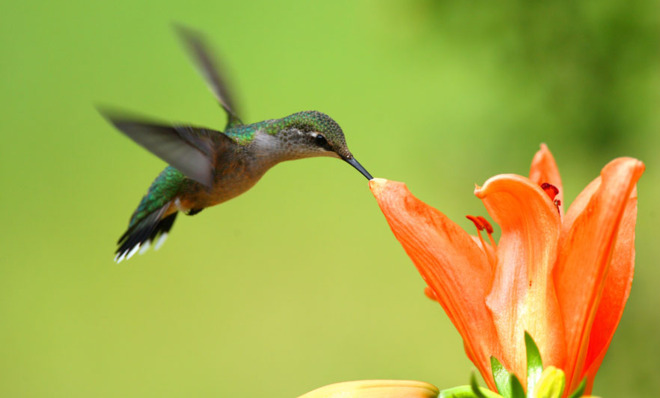The surprising reason most birds can't taste sugar
Dinosaurs!


Chickens are not fussy eaters. Any object resembling food is worth an exploratory peck. But give a chicken the choice between sugary sweets and seeds, and they will pick the grains every time. This is odd. Many animals, including our own sugar-mad species, salivate for sugar because it is the flavor of foods rich in energy. New research suggests that many birds' lack of interest in sugar is down to genes inherited from their dinosaur ancestors.
Most vertebrates experience sweet taste because they possess a family of genes called T1Rs. The pairing of T1R1 and T1R3 detects amino acids and gives rise to the savory "umami" taste, and the T1R2-T1R3 pair detects sugars and gives us our sweet tooth.
Maude Baldwin, a postgraduate student at Harvard University, searched the genomes of 10 species of birds from chickens to flycatchers. She found that insectivorous and grain-eating birds possess the gene pair that detects the amino acids present in insects and seeds, but none had the T1R2 gene responsible for the ability to taste sugar. These modern birds evolved from carnivorous theropod dinosaurs whose diets were rich in proteins and amino acids, but lacked sugar. So Baldwin reasoned that without a need to detect sweetness, ancient birds lost their T1R2 gene.
The Week
Escape your echo chamber. Get the facts behind the news, plus analysis from multiple perspectives.

Sign up for The Week's Free Newsletters
From our morning news briefing to a weekly Good News Newsletter, get the best of The Week delivered directly to your inbox.
From our morning news briefing to a weekly Good News Newsletter, get the best of The Week delivered directly to your inbox.
Hummingbirds appear to have bucked the trend. Every day they consume more than their own body weight in nectar. They can taste the difference between water and a sugar solution within a quarter of a second. And they also like the flavor of non-sugary artificial sweeteners like erythritol and sorbitol. How is this possible if they have no gene for sweet taste?
To answer this question, Baldwin cloned taste receptors from the sugar-insensitive chicken, from hummingbirds, and from the hummingbird's closest relative, the insect-eating chimney swift. Her results have been published in the journal Science. She discovered that while the T1R1 and T1R3 receptors in swifts and chickens only respond to amino acids, the same receptors in the hummingbird fire in response to sweet-tasting sugars, sugar alcohols, and the artificial sweetener sucralose, but not to amino acids.
Baldwin found that mutations in the hummingbirds' T1R1 and T1R3 genes have switched them from savory to sugar detectors. These mutations appear to be under positive selection, that is the proportion of protein-altering mutations is greater than we would expect by chance.
Hummingbirds have co-opted genes that originally allowed dinosaurs to savor the taste of flesh, and transformed them into the sugar detectors most modern birds live without.
A free daily email with the biggest news stories of the day – and the best features from TheWeek.com
Charles Darwin, scribbling in the rough notebooks to which he would later refer when writing The Origin of Species, pondered how animals in new environments learn which foods are worth eating and which should be avoided. He concluded that this problem drove the evolution of a sense of taste: "Real taste [in] the mouth, according to my theory must be acquired by certain foods being habitual — hence become hereditary."
Baldwin's results show that Darwin was spot-on. Perhaps ancestral hummingbirds that lacked the sweet receptor frequented flowers to catch insects. On occasion they accidentally consumed some nectar. Small mutations in T1R1 and T1R3 would have allowed them to taste this sugary liquid, giving them access to a vital source of energy. This could have given nectar-sipping individuals the evolutionary upper hand compared to insect-eaters.
Future research may focus on other nectar-eating birds such as sunbirds and lorikeets, and frugivores like tanagers, and whether they have undergone the same mutations as hummingbirds, or if a different mechanism explains their penchant for sugary foods.
More from The Conversation...
-
 Political cartoons for December 20
Political cartoons for December 20Cartoons Saturday’s political cartoons include drowning rats, the ACA, and more
-
 5 fairly vain cartoons about Vanity Fair’s interviews with Susie Wiles
5 fairly vain cartoons about Vanity Fair’s interviews with Susie WilesCartoon Artists take on demolition derby, alcoholic personality, and more
-
 Joanna Trollope: novelist who had a No. 1 bestseller with The Rector’s Wife
Joanna Trollope: novelist who had a No. 1 bestseller with The Rector’s WifeIn the Spotlight Trollope found fame with intelligent novels about the dramas and dilemmas of modern women